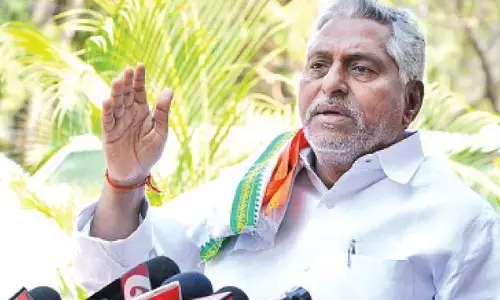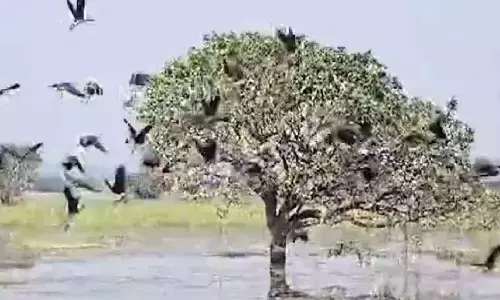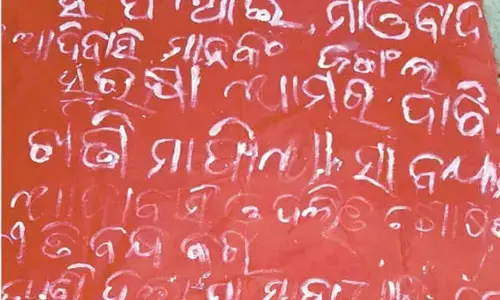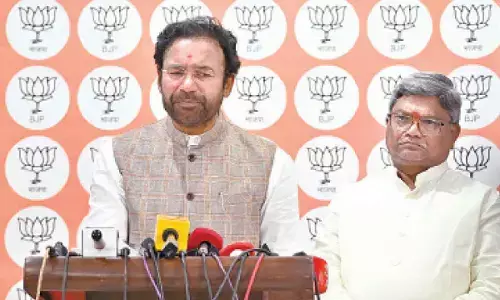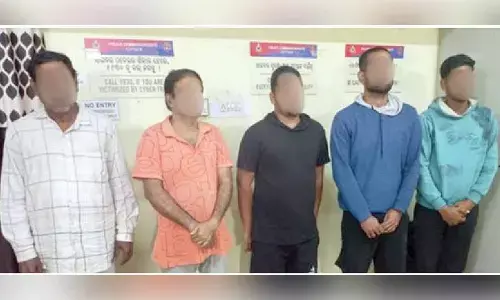35years on, still a benchmark

35years on, still a benchmark. Eminent filmmaker B Narsing Rao’s first production, the film marked Bengali documentary filmmaker Goutam Ghose’s foray into feature films and introduced a host of theatre artistes, including lead actor T Sai Chand and the late actress Telangana Shakuntala, on the silver screen.
It may be said that in the dearth of Telangana cinema, the seed for films on the Telangana Peasants Armed Struggle or the Telangana Rebellion began germinating, however slow it may be, with the film ‘Maa Bhoomi’ (Our Land), which was released 35 years ago on March 23, 1980. On its release, the film was declared a box office hit and ran for an year. It went on to win a Nandi Award and also a black lady at the Filmfare Awards in the best film category.The landmark film, which premiered at the Bangalore Filmotsav in January 1980, and subsequently at the International Film Festival of India, the Karlovy Vary Film Festival in July, the Cairo Film Festival and a bunch of prominent others, was instrumental in giving a platform for many new faces to establish careers in the industry. Eminent filmmaker B Narsing Rao’s first production, the film marked Bengali documentary filmmaker Goutam Ghose’s foray into feature films and introduced a host of theatre artistes, including lead actor T Sai Chand and the late actress Telangana Shakuntala, on the silver screen.

“Most of us were new to filmmaking and making the movie was an experience in itself. A lot of actors had never faced the camera before,” divulges Neelanjana Ghose, the director’s wife. “My husband and Narsing Rao gave the actors tips on how to make the movie as realistic as possible.” It must be mentioned here that Neelanjana was also the costume designer for the movie. “I had done a lot of research. But a lot of the clothes used in the film were borrowed from the people in the villages where we had shot,” Neelanajana says.The idea of making the film had taken over both director Ghose and producer-writer Rao after reading translations of Urdu writer Krishan Chander’s novel, ‘Jab Keth Jaage’, which was based on the Telangana Rebellion. The rebellion had peasants in the Telangana region picking up arms against feudal lords in the princely State of Hyderabad during the seventh and last Nizam Mir Osman Ali Khan’s rule.
The film details protagonist Ramaiah’s life in Siripuram village of Nalgonda district, where feudal lords (doras) or zamindars were in the habit of ill-treating their subjects. A farmer’s son, Ramaiah is fed up with the ill-treatment that the zamindars mete out to them. Following an incident where his love interest is forced to submit to sexual coercion, Ramaiah heads off to Hyderabad in order to begin a new life. Soon, he starts hobnobbing with communists who inspire him to stand up against the doras. The doras flee to the city. In September 1948, the Indian government’s Operation Polo suppresses the razakar movement and the Nizam’s government and accedes Hyderabad with the Indian Union. Soon after this, the doras, who pledge allegiance to the Indian National Congress, return to power, leaving the people of the region to face their fate all over again.
Narsing Rao, who had dabbled with many art forms, save film, was encouraged by his brother to experiment with the medium. Rao was enthusiastic about the prospect but didn’t have the necessary contacts. One fine day, an old friend, G Ravindranath, who was an engineer-turned-filmmaker and had produced one or two films, caught up with Rao and introduced him to a few people from the film industry. The two visited Calcutta-based filmmaker Mrinal Sen in Chennai and expressed their desire to make a film, albeit with a low budget. Sen wasn't game for the idea of a low budget movie, but he put them through to Goutam Ghose.
A known documentary filmmaker back then, Ghose, who had come out with his first documentary ‘New Earth’ in 1973 and followed it up with ‘Hungry Autumn’ in 1978, for which he won the main award at Oberhausen Film Festival, discussed several ideas through letters before deciding to work with Rao and Ravindranath on ‘Maa Bhoomi’.According to Rao, “The source material had a lot of unrealistic elements and had to be toned down to make it feel realistic. Hyderabad-based poet Makhdoom Mohiuddin was a good friend of Chander and might have narrated incidents of the rebellion to him. Chander himself had never come down to Hyderabad and hence most of the story was given to the swings in his imagination.”
Rao started digging up old archives at the State Library at Afzalgunj, Hyderabad, and tweaked the script enormously along with director Ghose and scriptwriter Partha Banerjee. The filmmakers then toured extensively around the State to interact with people who could recount first-hand experiences of the rebellion and the Indian government’s Operation Polo, who had seen and fought against the razakars, a private militia, owned by one Qasim Rizvi, that was responsible for killing and raping tens of thousands of Hindus in the State.The group also attended film festivals in the country to watch quality cinema and interact with personalities from the film industry. And by the time the perfect script was ready, it had little resemblance to its source material.
The majority of the cast was sourced from theatre groups and the others in the film comprised villagers and members of the general public. For playing the lead role, Sai Chand, who was all of 22, was roped in. Sai Chand had little experience prior to starring in the film. He was associated with his father’s (Tripuraneni Gopichand) theatre group, Gopichand Arts, and had staged a few plays but never had to face the movie camera. The young lad had several inhibitions before agreeing to act in the film but was convinced that he could play the role by Ghose and Rao, both of whom he sings immense praises of. “Goutam Ghose and B Narsing Rao brought out the best of me. The credit for my performance in the film must go to them,” an affable fifty-something Sai Chand shares.
“Filming the movie was not without difficulties,” tells Narsing Rao. The first schedule of filming began on the small budget sourced by the producers in July 1978 only to be hampered by incessant rains in the coming days. Spirits still soaring, the director, the principle cast and the crew persisted and shot at Mangalaparthi, Donthi and other such villages that were devoid of electricity so as to maintain the authenticity of the time period the film was set in, the 40s. A bottle of iodine was emptied almost every day to treat the crew for injuries. The director himself had sustained an injury that left him unable to walk. He was carried to the set in the hillocks to shoot a scene.
By the time the second and third schedules began the budget was exhausted and the producers had to mortgage their assets. Hit songs like “Palletoori Pillagada”, “Bandenaka Bandi Katti” and “Podala Podala Gatla Naduma”, the score for which was composed by Vinjamuri Seetha Devi, were all recorded in a library!“All the songs were recorded in a single day at the Max Mueller Library in Hyderabad. Being part of the Jana Natya Mandali, I had performed “Palletoori Pillagada” many times before the recording. Narsing anna saw me perform and asked me if I would like to sing for the movie,” shares Sandhya, whose melodious voice still rings in the ears of those who chirp notes of “Palletoori...”
Though the song, written a year or two before independence, was immensely popular in various art circles even before it made it on to the soundtrack of the film, the lyricist, Suddhala Hanumanthu, wasn't. It was only after Suddhala’s son, Ashok Teja, read that the song was being used in the film in a Telugu daily that he went to Narsing Rao seeking the credit to be given to his father, which was promptly done. Also, “Bandenaka Bandi Katti”, which is usually credited to singer Gaddar, was actually penned by revolutionary poet Bandi Yadagiri. “Podala Podala...” was collected from Nizamabad and sung by KVK Mohan Raju. There is an interesting story behind the song - it was discovered on a wall in Nizamabad jail and became a popular folk song.
Having completed shooting, with scenes in Hyderabad filmed at Old City, Puranapul and Gandhinagar, the producers were all but out of money to send the film for certification. Ravindranath had to give away his wedding ring as collateral for the film to be certified. After the struggle of making a film on a tight budget of Rs 5.3 lakh, the film had no takers. Another struggle ensued. Two distributors from Hyderabad and Vijayawada came forward and the movie was finally released in March 1980 to rave reviews.
Ever since its release, the film has gained a large number of admirers and continues to do so.On how the film had changed his life, Sai Chand says, “Several instances of the movie come back to me day in and day out. Even the most mundane incidents remind me of something that had happened in the movie or on the sets. One particular dialogue of my character – prajala kosam paatupadedanikanna manchi brathuku eymiti untadi, ayya? (Is there a better life than serving the people, father?) – has resonated with me through the years.”“No doubt, the movie has changed my life, but this dialogue in particular has moulded me. There is nothing better than serving the people,” the actor broods.
And rightly so. The film itself has served the people, establishing a landmark in the history of cinema for film enthusiasts and also the general public to go back to and witness a part of history that would have – given the paltry number of films on Telangana – otherwise gone undocumented.To commemorate the 35th anniversary, the makers of the film are organising a screening at Lamakaan, Banjara Hills, Hyderabad, on March 23. A Blu-ray disc of the film will be released on the occasion.
By E Sai Kishore








